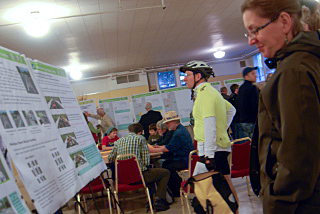
but said she often hesitates to bike
to visit a friend who lives near SE 40th Avenue,
because the current route feels like a hassle.
(Photos by M.Andersen/BikePortland)
Rich Newlands, the planner of one of the longest bikeway projects in Portland history, seemed relieved Thursday night for a chance to talk about something other than its most controversial 4,000 feet.
“It’s not all about the central section,” Newlands said, noting that the city faces a similar tradeoff between auto parking and comfortable biking between SE Gladstone and Steele, at its southern end, as well as a series of many route choices up the Alameda Ridge and across Killingsworth Street at its northern end.
Thursday’s open house on the 20s Bikeway, the first of three over the next week, was also a reminder that when bike access improvements can come without removing on-street auto parking or changing existing lane configurations, they’re almost totally uncontroversial.
“I can’t believe how fast people can go from Fremont to Klickitat — and with kids and pets,” said Denise Maki, 53, who lives near 26th and Fremont and called herself a “fair weather” biker. She said she had attended the meeting (which was held on the northern side of the future route) mostly because of a television report that had left her with the impression that parking would be removed from one side of the street all the way from NE Columbia to SE Steele.
Newlands and his colleagues were happy to inform her that auto parking north of Interstate 84 would be unaffected. Maki said she supports adding speed bumps to a north-south street in her area and that she’d “calm her neighbors.”
The major question facing the city for the northbound route is which of several neighborhood streets to take: 26th, 27th, 28th, 29th or 32nd. One key difference is that the corner of 32nd and Killingsworth is straighter than the others.
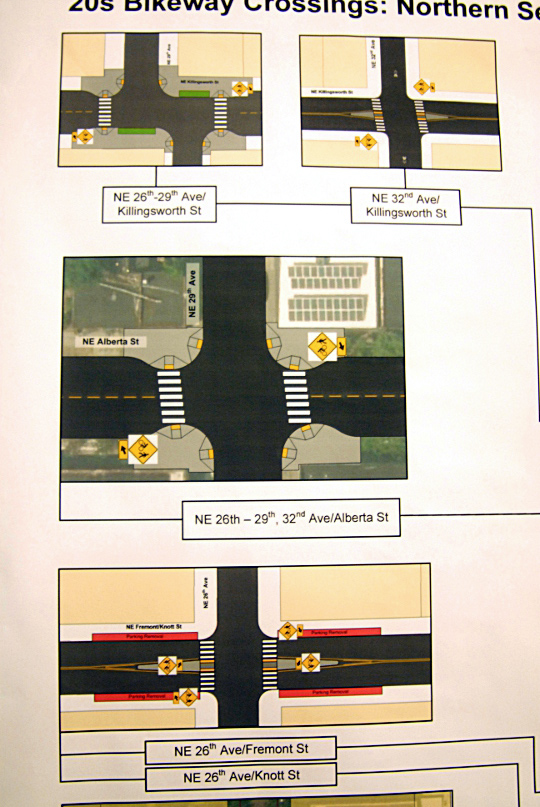
Jeff Walenta, 35, said he lives in the Buckman neighborhood and feels he has no good options for crossing major streets when he bikes north.
If that were his commute route, he said, “it would be when, not if, I would be hit” while crossing a big street, he said.
Another issue that Newlands wants to call attention to is the elbow of road between Powell Boulevard and Reed College. There, he said, the question for the city is whether to push for parking removal from one side of 26th Avenue between Gladstone and Steele in order to create a comfortable southbound buffered bike lane, which Newlands said would be a “great facility,” or to essentially give up on improving 26th, which south of Holgate is a commercial and light industrial street that gets regular truck traffic.
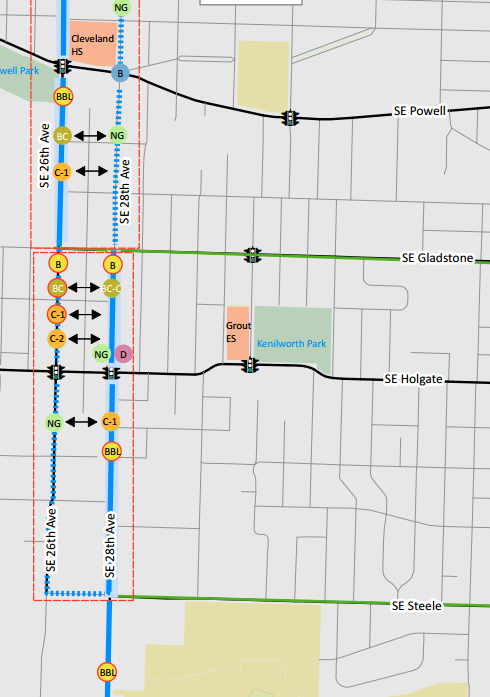
Newlands said his best guess is that the city would not add the buffered bike lane to 26th and would instead focus only on 28th, which (whether or not 26th is improved for biking) is slated to get speed bumps, sharrows and an entirely new traffic signal at Powell.
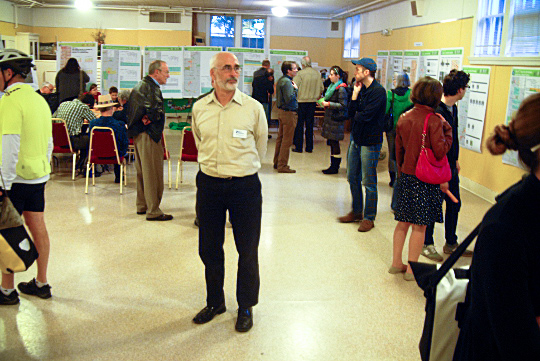
But even at Thursday’s event, many people wanted to talk about the most interesting part of the 20s Bikeway: the popular commercial district on 28th Avenue between Sandy Boulevard and Stark Street.
At issue is whether the city is best served by removing a lane of auto parking from the west side of 28th to add a southbound buffered bike lane and northbound green-backed sharrows, or whether it should attempt to route all bike traffic to the neighborhood greenway it intends to build on 30th.
Karen Mapes, 60, said she lives near the bikeway north of Interstate 84 and visits the commercial district regularly. “It doesn’t bother me if they take the parking out,” she said. “People will adjust.”
When she’s going somewhere parking is scarce, Mapes said, she’ll just take bicycle or transit instead. “I never drive downtown,” she said.
Heather Gramp, 44, lives in the Concordia neighborhood and said she’s a confident rider: not part of the so-called “interested but concerned” bikers that Portland says it designs its bikeways to serve.
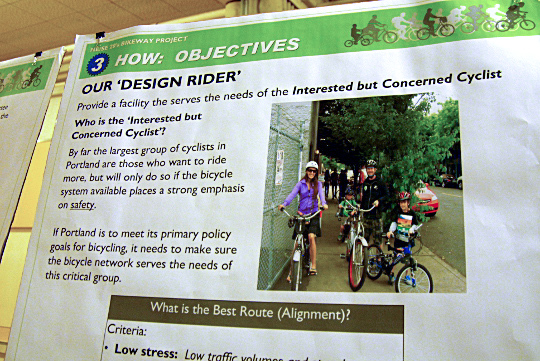
Gramp said her main interest is in improving pavement quality along bike routes. She said poor paving often deters her from using the neighborhood greenways along NE Going and NE Holman. But she also said the current state of 28th Avenue seems to have a psychological effect on her choices when she travels south.
“I have a friend who lives on SE 40th, and it’s always like, mmm, do I want to go over there?” she said.
Tom Huminski, 41, showed up Thursday with his son William, 4, who was wearing a Nutcase brand bike helmet.
“I would be fine with a buffered bike lane with my family,” Huminski said, looking at the city’s rendering for SE 28th. But rather than share a lane with cars or take any bike lanes that aren’t buffered, Huminski said, he’d probably take a side street, whether or not he was with his family.
“My MO whenever I’m in a situation like that is to go one street over,” he said. “Going Street right now, we like it. We ride it all the time.”
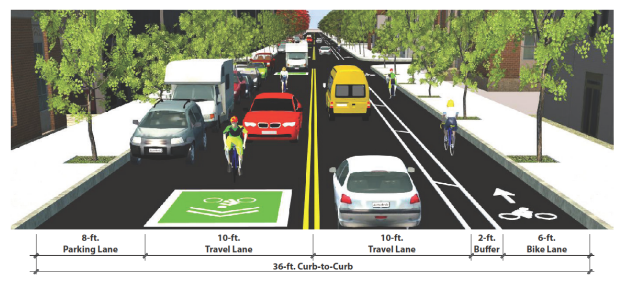
A few people at Thursday’s meeting seemed less interested in the details of the bikeway than in the general idea that the bikeway would impede auto traffic.
Jim Karlock, who said he lives a few blocks from the northern stretch of the bikeway, called the plan “sort of a de facto takeover of the streets” and said “it’s obviously past time for bikers to start paying road taxes.” He said removing auto parking, as on 28th or SE 26th, is “death for a business.”
Karlock compared the plans to a past sidewalk widening project along Sandy Boulevard, which he said was responsible for making Portland’s Hollywood District “not as thriving as it used to be” because it had constrained auto turns in order to make room for trees along the roadside.
Ray Splinter, 76, said he was also interested in licensing bicycles in order to raise money for bike-related projects. He added that “everybody needs to go back to school, bicyclists and motorists, to learn how to get along together.”
The city will hold two more open houses on the 20s Bikeway: one on Monday, March 17 near the southern section at Cleveland High School, 3400 SE 26th Avenue, and one on Tuesday, March 18 near the central section at Central Catholic High School, 2401 SE Stark. You can also share your opinion with project manager Rich Newlands by emailing rich.newlands@portlandoregon.gov.
More info on the 20s Bikeway Project:
– Past coverage on BikePortland
– PBOT’s official project page
